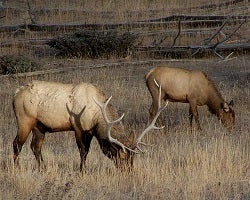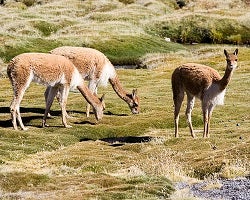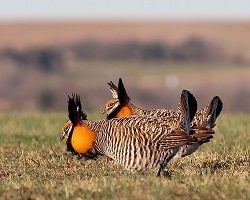The Herd Life

It's easy to see for a long distance on a grassland - as long as you're taller than the grass. Unfortunately, this means that for big animals, hiding from predators that would like to eat them isn’t easy. Large grassland herbivores have two main tactics to keep safe: they join herds and they are very, very fast.

Because herds make it harder for a predator to get a meal, they're always on the lookout for lone animals. Getting separated from the herd can mean death.
Built for Speed
When a herd spots danger, whether it's a fire or a predator, it has to outrun it. Many herd animals are able to run within a few hours of birth and have special adaptations for speed.
To be fast, an animal can either take big steps or it can move its legs very fast. Herd animals do both. Many are adapted to stand on the tips of their toes to lengthen their stride.

Hunting for Herds
Some predators have formed groups of their own. A pack of wolves might be able to chase a single animal away from its herd and kill it because they can work together. Since herd animals have become so fast, the predators that eat them need their own special adaptations to catch up. Some have become great sprinters, able to outrun their prey for short periods. Others lie in wait and pounce at just the right moment when the unwary herd passes by.
Burrowing Below Ground

You may be wondering whether small animals have as much trouble protecting themselves from predators as herd animals. Can't a little animal simply hide in the grass? Well, yes, but predators have keen ears and noses and it's just as hard to see a predator coming as it is for them to see you.
For real safety, many small grassland animals move underground into their burrows. Burrows provide a safe place to raise young and hide from predators, fire and bad weather. They also provide a place to store food for the future. Some burrowing animals even dig to find their food, which is often insects, worms or plant roots.
All sorts of grassland animals dig burrows, including insects, small mammals, reptiles like tortoises, and even a few birds. Even more animals use existing burrows that they might modify a bit. But even in burrows, some predators, like snakes, can find small animals.
Taking to the Air

Birds on the grasslands have the same problem as any other animal: how can they stay alive in a land with few trees when other animals want to have them for dinner?
Birds have a great advantage, though. They can fly. This can keep them safe from predators, unless they run into a raptor or owl.
The most dangerous time for a grassland bird is the time it spends on the ground. However, there aren’t very many trees in grasslands, so most grassland birds must come to the ground to sleep, to eat, and to mate and raise the next generation.

Images via Wikimedia. Secretary bird image via Keven Law.
Read more about: Grasping Grasslands
Bibliographic details:
- Article: Animals of the Grassland
- Author(s): Dr. Biology
- Publisher: Arizona State University School of Life Sciences Ask A Biologist
- Site name: ASU - Ask A Biologist
- Date published:
- Date accessed:
- Link: https://askabiologist.asu.edu/animals-grassland
APA Style
Dr. Biology. (). Animals of the Grassland. ASU - Ask A Biologist. Retrieved from https://askabiologist.asu.edu/animals-grassland
Chicago Manual of Style
Dr. Biology. "Animals of the Grassland". ASU - Ask A Biologist. . https://askabiologist.asu.edu/animals-grassland
Dr. Biology. "Animals of the Grassland". ASU - Ask A Biologist. . ASU - Ask A Biologist, Web. https://askabiologist.asu.edu/animals-grassland
MLA 2017 Style

Many predatory birds live in grasslands, like this secretary bird from Africa.
Be Part of
Ask A Biologist
By volunteering, or simply sending us feedback on the site. Scientists, teachers, writers, illustrators, and translators are all important to the program. If you are interested in helping with the website we have a Volunteers page to get the process started.

